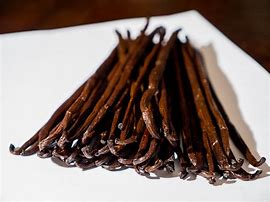Vanilla
Vanilla: A Precious and Universal Spice
Vanilla is one of the world’s most popular and valuable spices. Native to Central America and the Caribbean, it is extracted from the pods of specific orchids in the genus Vanilla. Renowned for its sweet and rich aroma, vanilla is widely used in cooking, perfumery, and even traditional medicine.
Origin and History
Mesoamerican civilizations, such as the Aztecs and Mayans, were the first to use vanilla. The Aztecs called it “tlilxochitl,” meaning “black flower,” referring to the appearance of the dried pods. They often combined it with cocoa to create a rich, aromatic beverage.
Vanilla was introduced to Europe in the 16th century by Spanish explorers. It quickly became a sought-after commodity, but its cultivation was limited to Mexico until a manual pollination method was discovered in the 19th century.
Vanilla Cultivation
Vanilla is a delicate plant requiring specific conditions to thrive. It grows primarily in tropical regions, with production concentrated in countries like Madagascar, Indonesia, and Mexico.
Pollination is a crucial step, as most vanilla varieties grown outside Mexico lack access to their natural pollinator, a small bee called Melipona. Manual pollination, discovered by a slave named Edmond Albius in Réunion, revolutionized the vanilla industry.
Processing the Pods
Producing vanilla is a lengthy and labor-intensive process. The pods, harvested at maturity, undergo several steps: scalding, fermentation, drying, and curing. This process, lasting several months, is essential to develop the characteristic flavor and aroma of vanilla.
Types of Vanilla
- Bourbon Vanilla: Primarily grown in Madagascar, known for its creamy and sweet aroma.
- Tahitian Vanilla: Originating from French Polynesia, it offers unique floral and fruity notes.
- Mexican Vanilla: Rarer and prized for its deep, spicy aroma.
Uses of Vanilla
Vanilla is an essential ingredient in many desserts, such as ice cream, pastries, and sauces. It is also used in the production of perfumes and cosmetics for its soothing properties. In traditional medicine, vanilla is sometimes used for its relaxing and digestive benefits.
Challenges and Perspectives
Vanilla production faces several challenges, including climate conditions, pod theft, and price fluctuations. However, global demand remains strong, and initiatives promoting sustainable and fair production are emerging in many producing regions.
Conclusion
A symbol of luxury and refinement, vanilla is much more than just a spice. Its rich history, demanding cultivation methods, and unique aroma make it a global treasure. Whether in your kitchen or your favorite perfume, vanilla continues to delight the senses and showcase the artisanal expertise of its producers.


